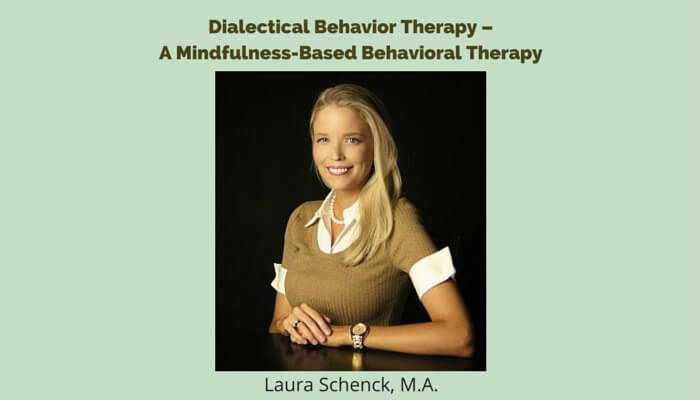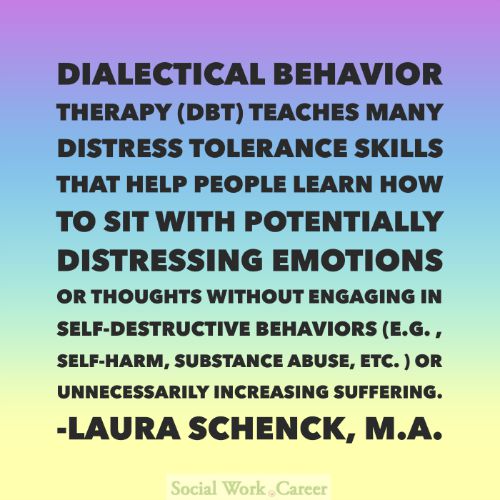What is dialectical behavior therapy (DBT)?
This week, we have the pleasure of an interview on this very topic with Laura Schenck, M.A.. You will have the opportunity to learn what dialectical behavior therapy is and be provided with a brief overview of this modality.
As per Laura, “DBT makes use of some standard CBT principles and techniques… to encourage distress tolerance and emotion regulation” and “in order to move through painful experiences, we must be willing to identify them, accept their presence, refrain from judgment, and ultimately release them.”
Laura is currently in her third-year as a Ph.D. student, working on her dissertation proposal, and providing psychotherapy for college students at the University of Northern Colorado’s (UNC) counseling center. Her therapeutic approach stems from the mindfulness-based behavioral therapies of both Acceptance and Commitment Therapy (ACT) and Dialectical Behavior Therapy (DBT).
 So without further ado, Laura, could you describe for us a bit of your background?
So without further ado, Laura, could you describe for us a bit of your background?
I was initially interested in philosophy when I began my undergraduate studies at St. John’s College in Santa Fe, New Mexico. My academic interests gradually evolved from an interest in why things are the way that they are to why people are the way that they are.
I graduated from St. Edward’s University in Austin, TX, in 2007 with a B.A. in psychology. During my time at St. Edward’s University, I realized that I wanted to begin a graduate program in psychology where I could learn the counseling skills necessary to help people move toward their chosen life goals and dreams.
I began an M.A. program in mental health counseling at Boston College and graduated in 2010. During this program, I realized that I wanted to further my education within a Ph.D. program of counseling psychology. I began my doctoral studies in the counseling psychology program at the University of Northern Colorado (UNC) in the fall of 2010 and have been taking coursework and seeing clients ever since.
What made you decide to specialize in Dialectical Behavior Therapy modality?
I was drawn to Dialectical Behavior Therapy (DBT) because of its focus on teaching individuals the skills that enable meaningful behavioral changes in their lives. Dr. Marsha Linehan, the founder of DBT, emphasizes that while individuals are not responsible for “all” of their current problems, they are faced with the task of dealing with them in the present moment nonetheless.
It does little good to spend significant amounts of time in therapy (or in one’s private life) to dwell excessively on early life experiences with the goal of placing blame or hoping for some form of golden insight. While insight may feel like a relief in the moment, it requires the willingness and commitment to make positive behavioral changes.
In this way, I appreciate DBT’s consistent emphasis on encouraging people to do different things in their lives if they wish to get different results than they have in the past. The idea that we can persist in repetitive unhealthy, ineffective, or self-destructive behaviors time and time again – and expect different results – keeps people stuck not only in unhealthy behavioral patterns, but attached to self-defeating beliefs such as “I’m just no good at this” or “I’m a failure.”
I have attended two different DBT workshops (on mindfulness and emotion regulation) that were both led by Dr. Marsha Linehan. I was consistently impressed by her enthusiasm for and commitment to the application of DBT principles to treatment with clients who significantly benefit from the skills of DBT’s 4 modules: mindfulness, distress tolerance, emotion regulation, and interpersonal effectiveness.
Could you give a brief description of what Dialectical Behavior Therapy (DBT) is?
Dialectical Behavior Therapy (DBT) emerged from principles of Cognitive Behavioral Therapy (CBT) as a “third wave behavioral therapy.” DBT makes use of some standard CBT principles and techniques (e.g., identifying thoughts/behaviors and looking for evidence that a particular thought, emotion, or behavior is “justified” – or based in actual events/facts) to encourage distress tolerance and emotion regulation.
DBT adds the concept of mindfulness, as the underlying foundation behind all DBT skills. Mindfulness is all about directing a certain type of attention to the present moment that involves an attitude of non-judgment, openness, acceptance, and curiosity.
Since DBT is essentially a mindfulness-based behavioral therapy, it encourages individuals to increase awareness of thoughts, emotions, and behaviors with greater openness and acceptance in the present moment. For many people, the very idea of sitting with uncomfortable experiences is difficult to imagine, much less choosing to direct a nonjudgmental and welcoming attitude toward those unpleasant experiences.
The key is that in order to move through painful experiences, we must be willing to identify them, accept their presence, refrain from judgment, and ultimately release them. This process involves learning how to see thoughts and emotions – however painful they may be in the present moment – as just thoughts (not “facts”) and just emotions (that are temporary states of being).
This process does not negate the personal experience of however painful it may be to experience certain thoughts and emotions, but practicing mindfulness enables us to accept the inherent pain involved in life without adding additional suffering. Pain is inevitable; suffering is optional.
DBT adds the unique component of focusing on creating positive changes through recognizing and managing dialectical tensions. Many clients who benefit the most from DBT struggle with dichotomous thinking (i.e., “black-and-white” / “all-or-nothing” thinking) and are able to make lasting positing behavioral changes in their lives through understanding how to allow seemingly opposing internal states to exist together.
For example, it is possible to feel conflicted emotions towards the same person, recognizing that sometimes that person may be happy or kind sometimes and other times irritable or angry. The idea is to mentally hold two opposing thoughts/emotions in one’s mind at the same time and integrate (i.e., synthesize or bring together) those apparent opposites to gain a greater (i.e., more realistic and healthy) understanding of the nuances involved in relationships and in life.
People are neither “all good” nor “all bad,” although many people who struggle with Borderline Personality Disorder (BPD) have difficulty integrating opposites such as this, which makes it challenging to create a more realistic, healthy, and nuanced understanding of themselves, others, and the world.
DBT also includes the idea of “wise mind,” which teaches individuals how to access their deep inner wellspring of intuitive knowing. Learning how to access wise mind encourages people to trust themselves and their ability to choose effective behaviors that are in their best interest.
DBT rests upon clients learning the critical skills of distress tolerance, mindfulness, emotion regulation and interpersonal effectiveness. Can you explain what these skills are and how they may be helpful?
Mindfulness is a “mental state characterized by nonjudgmental awareness of the present moment experience, including sensations, thoughts, bodily states, consciousness, and the environment, while encouraging openness, curiosity, and acceptance” (Hofmann et al., 2010, p. 169).
DBT teaches people how to practice a wide variety of mindfulness exercises to become more present and focused in the moment, which allows them to more effectively tolerate uncomfortable emotions, manage those emotions, and relate more effectively to others.
An incredible benefit of learning to practice mindfulness is that it allows people to truly accept experiences (including unwanted thoughts and painful emotions) instead of habitually reacting to them with an attitude of fear and avoidance.
It is through this present-moment awareness of internal and external experiences precisely they are – with no attempts to change them – that people develop cognizance of an potentially untapped inner strength capable of handling life’s difficulties with greater poise and effectiveness than considered possible. Mindfulness simply involves noticing and accepting the moment… right now.
Distress tolerance is “the ability to perceive one’s environment without putting demands on it to be different; to experience one’s current emotional state without attempting to change it; and to observe one’s own thoughts and action patterns without attempting to stop or control them” (Linehan, 1993, p. 147).
DBT teaches many distress tolerance skills that help people learn how to sit with potentially distressing emotions or thoughts without engaging in self-destructive behaviors (e.g., self-harm, substance abuse, etc.) or unnecessarily increasing suffering. These skills include relaxation techniques, visualization exercises, and techniques designed to increase one’s capacity to self-soothe (i.e., provide oneself with a source of calm, comfort, and security) in the face of distress.
Emotion regulation skills involve learning how to effectively identify, manage, cope, and respond to internal emotional states (e.g., anger, sadness, guilt, fear, joy, envy, etc.). DBT teaches emotion regulation skills with the goal of increasing confidence and competence in abilities to accurately identify emotional experiences, reduce vulnerability to intense emotions, increase positive emotions, and change intensely distressing emotional states through practicing “opposite action.” Briefly, opposite action entails applying yourself to tasks that you do not feel like doing so as to propel yourself in a positive direction.
Interpersonal effectiveness involves learning to communicate with and relate to other people more effectively and harmoniously. DBT teaches interpersonal effectiveness skills that focus on building healthy assertiveness (i.e., behaviors that are neither passive nor aggressive), engaging in active listening, and identifying potential obstacles to interpersonal effectiveness that may be interfering with positive/healthy relationships (e.g., threatening, blaming, guilt-tripping, belittling, withdrawing, etc.)
Could you tell us about the “wise mind” tool and how this is used?
As I began to mention previously, “wise mind” is a concept that Dr. Marsha Linehan has incorporated into DBT to teach people how to access the healthy and wise part of themselves when making decisions – deep and heartfelt intuitive knowing. The idea behind wise mind is that we all have the capacity to know what is truly in our best interest – it is just a matter of knowing how to listen to this voice within and then take effective action based on what wise mind is telling us.
When people learn about wise mind in DBT, they are taught that we all operate on a continuum between “emotion mind” and “reason mind,” with wise mind acting as the balance between the reasonable mind and emotion mind (i.e., the healthy and balanced integration of emotion with reason).
When we are operating solely out of emotion mind, things may feel hot, impulsive, and hurried. There is often a tendency to act solely based upon emotional input and processes, with little to no integration from our more thoughtful or reasonable side. This often leads to making hasty decisions, engaging in impulsive behaviors, or becoming intensely overwhelmed by emotions.
On the other hand, when operating solely out of reason mind, there is often a sense of coldness, detachment, and disconnection that results from overly identifying with reason and logic (at the expense of ignoring emotional input). When we choose to only utilize our capacity for reason, problem solving, and thought, we miss out on the important and relevant information that our emotional side holds.
The idea is that neither emotion nor reason are necessarily “better” than the other, but rather to become mindfully aware of information from both sides and integrate them in a way that is most likely to bring about healthy outcomes.
Why would DBT be particularly effective for clients with borderline personality disorder (BPD)?
DBT has demonstrated extensive and strong empirical support in the effective treatment of Borderline Personality Disorder (BPD), especially in significantly reducing suicidal and self-harming behaviors.
It is particularly effective for people struggling with BPD due to the common tendency toward engaging in dichotomous thinking, becoming overwhelmed by intense emotions, turning toward self-destructive/impulsive behaviors during times of distress, and a heightened sensitivity and/or difficulty in effectively relating with others in healthy ways.
DBT teaches the skills necessary to address all of the primary behavioral issues associated with BPD. (For more in-depth information on the empirical support for DBT in the treatment of BPD, see Behavioral Tech’s “What is DBT?” page.)
In light of the fact that many people may benefit from more emotion regulation or mindfulness, do you find yourself employing components of DBT therapy with clients who do not suffer from borderline personality disorder (BPD)?
I absolutely integrate mindfulness-based techniques / interventions and emotion regulation skills with clients without a diagnosis of BPD. In fact, mindfulness based therapies such as Acceptance and Commitment Therapy (ACT) and Mindfulness-Based Cognitive Therapy (MBCT) are commonly and successfully used with people who do not suffer from BPD or any other personality disorder(s).
DBT has many skills that are incredibly helpful for people who are suffering from emotional or relational problems that have nothing to do with a BPD diagnosis. For example, the majority of people that I provide counseling services to and interact with outside of a counseling setting could stand to benefit from gaining greater mindfulness in their daily lives.
Our culture places such great value on success, achievement, and being “busy,” that many people find themselves operating on automatic pilot a great deal of the time. Through regular mindfulness practices, people can learn to become more present to their lives – their thoughts, emotions, sensations, and relationships with others.
Just as most people could experience benefits as a result of being more mindful, many people could also benefit from learning to regulate their emotions more effectively. Increasing emotional regulation allows people to more accurately identify emotional states and respond to them with greater intention.
I believe that many clients and people not engaged in therapy receive powerful positive benefits in their lives through learning how to respond rather than react to thoughts, emotions, sensations, and interactions with others. I have witnessed many clients (without a diagnosis of BPD) make incredible positive changes in their lives as a result of learning how to practice mindfulness, tolerate distress, regulation emotions, and relate more effectively with people in their lives.
What kind of applications, if any, have you used to assist you with your DBT work with clients?
Dr. Linehan is in the process of creating and releasing a DBT skills app for the iPhone and Android that shows great promise. The app contains instructional videos, led by Dr. Linehan herself, going over various DBT skills. This app should be released sometime in 2012, and I certainly look forward to seeing how useful it is in work with clients.
There are already a variety of other apps out there – particularly created for use with cognitive behavioral therapy principles – that have demonstrated success. There is certainly a movement in the mental health field toward integrating the use of technology (e.g., through smartphones, e-mail, Skype/video-conferencing, etc.) and research studies are becoming more common as far as understanding how effective this use of technology will be for clients.
While I have yet to use or promote use of these online tools with my own clients, there are many times when I have referred clients to my website to read an article about a specific topic/issue they are currently dealing with in their life. It has been helpful for some clients to read and print out mindfulness exercises from the website, so that they may practice mindfulness skills on their own in between weekly sessions.
Finally, where would you recommend that mental health professionals get their training in this important modality?
The best resource for DBT training that is endorsed by Dr. Marsha Linehan is on the training page of the Behavioral Tech website. This is where I learned about the two DBT workshops that I have attended, in which I had very positive experiences.
Thanks so much, Laura, for providing us with this wonderful introduction to dialectical behavior therapy !
Feel free to follow Laura Schenck on twitter at @MindfulnessMuse or visit her Mindfulness Muse website.
References:
Linehan, M.M. (1993). Cognitive-behavioral treatment of borderline personality disorder. New York, NY: The Guilford Press.
Hofmann, S.G., Sawyer, A.T., Witt, A.A., & Oh, D. (2010). The effect of mindfulness-based therapy on anxiety and depression: A meta-analytic review. Journal of Consulting & Clinical Psychology, 78(2), 169-183.




